Hopper liked to go driving when he was looking for inspiration, and subjects drawn from the highway figure prominently in his work. This is perhaps the most striking of them all, vividly suggesting the anxious sense of isolation that a lonely road can bring as night falls. Hopper did not depict a specific site here, but put together a synthesis in the studio from sketches he had made at various places.
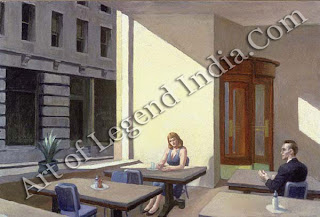 The figures in Hopper's paintings rarely communicate directly with one another, and here he brilliantly depicts a feeling of hesitancy. The man looks vacantly towards the window, but his thoughts are surely on the girl, while she sits fidgeting with her hands.
The figures in Hopper's paintings rarely communicate directly with one another, and here he brilliantly depicts a feeling of hesitancy. The man looks vacantly towards the window, but his thoughts are surely on the girl, while she sits fidgeting with her hands.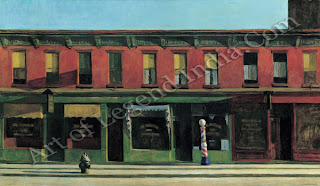 The inspiration for this picture probably came from a stage set for the play Street Scene by Elmer Rice, which Hopper saw in New York in 1929. Like the picture, the set featured a rather bleak two-storey block seen flat on and stretching the entire width of the stage. Hopper found architecture a very appealing subject, as it gave him the clarity and firmness of line he loved. Here he needs no human presence to create a sense of pictorial drama, relying instead on the bold forms and the morning light.
The inspiration for this picture probably came from a stage set for the play Street Scene by Elmer Rice, which Hopper saw in New York in 1929. Like the picture, the set featured a rather bleak two-storey block seen flat on and stretching the entire width of the stage. Hopper found architecture a very appealing subject, as it gave him the clarity and firmness of line he loved. Here he needs no human presence to create a sense of pictorial drama, relying instead on the bold forms and the morning light.Appropriately for someone who enjoyed travelling so much, hotel rooms and lobbies were favourite subjects of Hopper's. The soullessness of the surroundings and the boredom and frustration of waiting provided him with ideal subject matter. Here he also conveys a feeling of tension, suggested by the woman's expression and rigid pose, but as usual he makes nothing explicit.
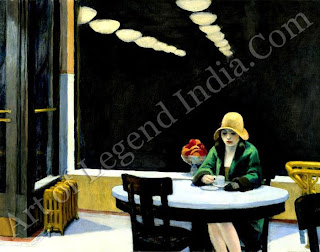 Hopper was a very careful and deliberate worker and he had an uncanny gift for achieving a perfect bala UT between figure and setting, setting is never simply a background for some action and his figures never just animating details in an urban landscape. Here the single let figure is unerringly placed in her commonplace surroundings, d her troubled isolation, as she contemplates her life over a cup of coffee, comes over with great immediacy. As always with Hopper, all the details ring true and he achieves his goal naturally, without any striving for effect.
Hopper was a very careful and deliberate worker and he had an uncanny gift for achieving a perfect bala UT between figure and setting, setting is never simply a background for some action and his figures never just animating details in an urban landscape. Here the single let figure is unerringly placed in her commonplace surroundings, d her troubled isolation, as she contemplates her life over a cup of coffee, comes over with great immediacy. As always with Hopper, all the details ring true and he achieves his goal naturally, without any striving for effect.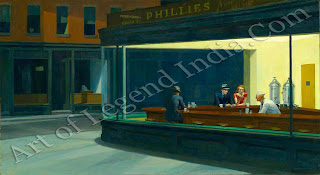 Hopper's most famous painting was 'suggested by a restraint t on Greenwich Avenue where two streets meet'. Although he hated discussing his work, Hopper was a little more forthcoming than usual about this picture: Nighthawks seems to be the way I think of a night street. I didn't see it as particularly lonely. I simplified the scene a great deal and made the restaurant bigger. Unconsciously, perhaps, I was painting the loneliness of a large city.
Hopper's most famous painting was 'suggested by a restraint t on Greenwich Avenue where two streets meet'. Although he hated discussing his work, Hopper was a little more forthcoming than usual about this picture: Nighthawks seems to be the way I think of a night street. I didn't see it as particularly lonely. I simplified the scene a great deal and made the restaurant bigger. Unconsciously, perhaps, I was painting the loneliness of a large city.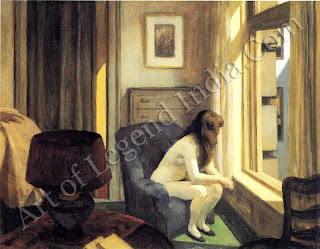 The central themes of Hopper`s work is the spiritual emptiness of f modern urban life and here he shows a woman staring listlessly out of her window at another uneventful day. Her facial expression is not shown but Hopper masterfully conveys her weariness through the sluggish altitude of her body. Although his work is in many ways austere, Hopper was extremely frank in his depiction of the nude, and figures here a very solid sense of physical presence, in keeping finless of structure of the picture as a whole.
The central themes of Hopper`s work is the spiritual emptiness of f modern urban life and here he shows a woman staring listlessly out of her window at another uneventful day. Her facial expression is not shown but Hopper masterfully conveys her weariness through the sluggish altitude of her body. Although his work is in many ways austere, Hopper was extremely frank in his depiction of the nude, and figures here a very solid sense of physical presence, in keeping finless of structure of the picture as a whole. 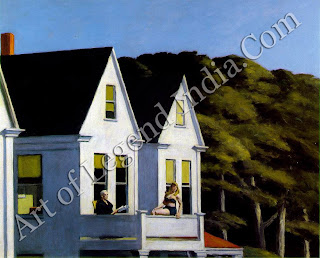
In his usual self-effacing way, I topper said this picture was only 'an attempt to paint as white with almost no yellow pigment in the white. Any psychological idea will have to be supplied by the viewer.

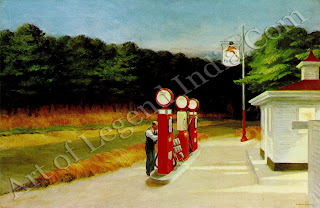
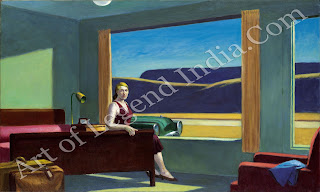










0 Response to "Painting Gallery of Edward Hopper"
Post a Comment